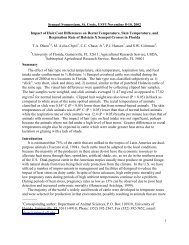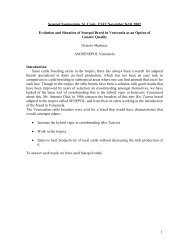Native Tree Sheet: Coco Plum - University of the Virgin Islands
Native Tree Sheet: Coco Plum - University of the Virgin Islands
Native Tree Sheet: Coco Plum - University of the Virgin Islands
Create successful ePaper yourself
Turn your PDF publications into a flip-book with our unique Google optimized e-Paper software.
<strong>Native</strong> <strong>Tree</strong> <strong>Sheet</strong>:<br />
<strong>Coco</strong> <strong>Plum</strong><br />
Chrysobalanus icaco<br />
Rose Family (ROSACEAE)<br />
By Brian Daley and Thomas W. Zimmerman, Ph.D.<br />
UVI-AES Biotechnology & Agr<strong>of</strong>orestry<br />
A publication <strong>of</strong> <strong>the</strong> <strong>University</strong> <strong>of</strong> <strong>the</strong> <strong>Virgin</strong> <strong>Islands</strong> Agricultural Experiment Station October, 2007<br />
Figure 1. Immature, green fruits develop at <strong>the</strong> ends <strong>of</strong> coco plum branches.<br />
Common Names<br />
<strong>Coco</strong> plum (West Indies), fat pork (Lesser<br />
Antilles), icaco (Puerto Rico).<br />
Description<br />
A small- to medium-sized, multi-stemmed,<br />
shrubby tree usually reaching less than 10<br />
feet tall. The bark is brown to grey, smooth or<br />
becoming scaly. The highly branched canopy<br />
is dense and dark green. The thick, lea<strong>the</strong>ry<br />
leaves are simple, opposite, upturned<br />
along <strong>the</strong> branches and yellowish-green on<br />
<strong>the</strong> underside. Clusters <strong>of</strong> small, greenishwhite<br />
flowers grow at <strong>the</strong> leaf base. There<br />
are two distinct varieties to this species. The<br />
imported variety has a relatively small, oval,<br />
dark purple fruit. The o<strong>the</strong>r has a larger (1<br />
½ inches long), sweet, edible, round fruit,<br />
colored pinkish white, and is found more<br />
commonly in <strong>the</strong> <strong>Virgin</strong> <strong>Islands</strong>.<br />
Distribution and Ecology<br />
<strong>Coco</strong> plum is native to coastal areas from<br />
south Florida to <strong>the</strong> Caribbean islands,<br />
Mexico and Central and South America.<br />
Plants <strong>of</strong>ten grow in thickets on sandy<br />
soils or singly on rocky coastal outcroppings.<br />
They are highly tolerant <strong>of</strong> drought,<br />
wind and even salt spray, but do poorly in<br />
wet or shady conditions.<br />
Flowering and Fruiting<br />
Flowering can occur throughout <strong>the</strong> year,<br />
but populations usually flower at <strong>the</strong> same<br />
time. Likewise, fruit production is variable<br />
but has distinct peaks. The flesh is astrin-<br />
Figure 2. <strong>Coco</strong> plum leaves, flowers and<br />
fruits (Illustration from Little et al.).<br />
gent tasting when green and slightly sweet<br />
when ripe. There is one hard, woody stone<br />
in <strong>the</strong> center <strong>of</strong> each fruit containing a<br />
fatty, edible seed. Ripe fruit was collected<br />
in <strong>the</strong> Sandy Point Wildlife Refuge (SPWR)<br />
from August to January in different years.<br />
Fruits from Puerto Rico and o<strong>the</strong>r locations<br />
are reported to weigh roughly 0.14 oz (4 g),<br />
while several collections from SPWR averaged<br />
0.48 oz (12.71 ±0.81), roughly triple<br />
that size.<br />
Seed Collection and Processing<br />
Ripe fruits with mature seeds should be<br />
taken directly from <strong>the</strong> plant when <strong>the</strong> fruit<br />
is pink and spongy. Flesh should be removed<br />
from <strong>the</strong> woody nut to prevent fungal<br />
infection <strong>of</strong> <strong>the</strong> seed. Preparing large
Figure 3. Ripe fruit and cleaned seeds ready to be planted. Figure 4. Early development stages <strong>of</strong> coco plum with a U.S quarter<br />
used for size reference.<br />
quantities <strong>of</strong> seeds is time-consuming,<br />
but made easier by soaking <strong>the</strong> fruits in<br />
water and scraping <strong>the</strong>m across a coarse<br />
screen. There is an average <strong>of</strong> 200 seeds<br />
per pound (445 seeds/kg).<br />
Seed Treatments and Germination<br />
The large seeds should be started in deep<br />
germination trays in well-drained potting<br />
mix. Germination begins between 35 and<br />
40 days. Clean seeds germinate at 75%<br />
success without any fur<strong>the</strong>r treatment.<br />
During experiments at UVI-AES, manual<br />
and acid scarification, soaking in water<br />
and hormone treatments did not increase<br />
germination rates nor cause <strong>the</strong> process to<br />
begin significantly earlier, so none is recommended.<br />
Greenhouse Management<br />
Seedlings should be transplanted to pots<br />
after formation <strong>of</strong> <strong>the</strong> third leaf. These<br />
plants are susceptible to over-watering,<br />
which causes <strong>the</strong> leaves to turn brown and<br />
may even kill <strong>the</strong> plant. Use well-drained<br />
potting soil with coarse sand or perlite and<br />
do not over-pot. Even young plants are extremely<br />
drought and salt tolerant and can<br />
be quickly acclimated to full sun.<br />
Outplanting and growth<br />
Growth is slow both in <strong>the</strong> greenhouse and<br />
in <strong>the</strong> field. UVI-AES experiments to establish<br />
coco plum in hilly areas with caliche<br />
soil have been mostly unsuccessful.<br />
Landscape Uses<br />
<strong>Coco</strong> plum is well suited for beach plantings,<br />
coastal erosion control, as well as<br />
landscape use. It does well when planted<br />
closely toge<strong>the</strong>r and can be shaped into a<br />
hedge (such as <strong>the</strong> imported purple-fruited<br />
variety planted at <strong>the</strong> airport in St. Croix).<br />
New leaves are red at first <strong>the</strong>n turn green,<br />
giving a pleasant texture and variety to<br />
group plantings.<br />
Traditional Uses<br />
The fruit is slightly sweet and can be eaten<br />
raw or used in preserves. The seed is also<br />
edible, has high oil content and a nutty, but<br />
somewhat bland, flavor. It is also reported<br />
to be a good honey plant.<br />
For fur<strong>the</strong>r information contact Brian Daley,<br />
Research Specialist, <strong>University</strong> <strong>of</strong> <strong>the</strong> <strong>Virgin</strong><br />
<strong>Islands</strong> Agricultural Experiment Station,<br />
RR 1 Box 10,000, Kingshill, VI 00850.<br />
(340) 692-4078, bdaley@uvi.edu<br />
Additional Reading<br />
Francis, J.K and A. Rodriguez. 1993. Seeds<br />
<strong>of</strong> Puerto Rican trees and shrubs: second<br />
installment. Research Note SO-374. U.S.<br />
Department <strong>of</strong> Agriculture, Forest Service,<br />
Sou<strong>the</strong>rn Forest Experiment Station. New<br />
Orleans, LA 5p.<br />
Jones, K., 1995. <strong>Native</strong> <strong>Tree</strong>s for Community<br />
Forests. St. George Village Botanical<br />
Garden <strong>of</strong> St Croix, Inc. 124 p.<br />
Little, E.J, Woodbury, R.O. and Wadsworth,<br />
F.H. 1974. Common <strong>Tree</strong>s <strong>of</strong> Puerto Rico<br />
and <strong>the</strong> <strong>Virgin</strong> <strong>Islands</strong>, Second Volume.<br />
Agriculture Handbook No. 449 U.S. Department<br />
<strong>of</strong> Agriculture, Forest Service.<br />
Washington, D.C. 1024 p.<br />
Prepared by Brian Daley, Agr<strong>of</strong>orestry Research Specialist, and Dr. Thomas W. Zimmerman, Biotechnology Program Leader. Issued by<br />
<strong>the</strong> <strong>University</strong> <strong>of</strong> <strong>the</strong> <strong>Virgin</strong> <strong>Islands</strong> Agricultural Experiment Station, Dr. James Rakocy, Director. This work was made possible through support<br />
from a USDA McIntire-Stennis grant # UVI-201073. USDA-Cris 0201950.<br />
<strong>University</strong> <strong>of</strong> <strong>the</strong> <strong>Virgin</strong> <strong>Islands</strong><br />
Agricultural Experiment Station<br />
RR 2, Box 10,000<br />
Kingshill, VI 00850<br />
Telephone: (340) 692-4020<br />
Fax: (340) 692-4035<br />
http://rps.uvi.edu/AES/aes_home.html









